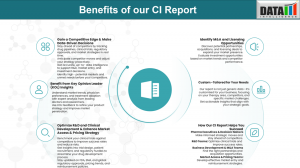Race to Treat Frontotemporal Dementia Heats Up as Gene, mAb and Small-Molecule Programs Near Late-Stage Read-outs
Frontotemporal dementia is no longer an orphan of innovation. The winners will be those who pair genetic precision with real-world practicality and prove they can slow the clock on brain atrophy.”
AUSTIN, TX, UNITED STATES, June 5, 2025 /EINPresswire.com/ -- Frontotemporal Dementia (FTD) has long stood apart from Alzheimer’s disease-rarer, younger in onset, and devoid of any therapy proven to change its relentless course. That could soon change. A wave of programs targeting the underlying biology of FTD is approaching pivotal read-outs, led by monoclonal antibodies that boost progranulin, adeno-associated virus (AAV) gene therapies designed for durable expression, and first-in-class small molecules that cross the blood–brain barrier to increase progranulin from within the cell.— DataM Intelligence
Disease Snapshot
FTD accounts for fewer than one in thirty diagnosed dementia cases, yet its impact on working-age adults is outsized. Most patients present between 45 and 64 years of age, often after months of unexplained personality change, language loss or impulsive behavior that disrupts employment and family life. With no disease-slowing agent on the market, care remains limited to selective serotonin re-uptake inhibitors for disinhibition, low-dose antipsychotics for severe agitation, and symptomatic speech or occupational therapy.
Download Free CI Sample Report: https://www.datamintelligence.com/strategic-insights/sample/frontotemporal-dementia-ftd
From Silence to Sprint: An Expanding Clinical Pipeline
Momentum began to build when loss-of-function mutations in the GRN gene were identified as a major monogenic driver of familial FTD. Progranulin insufficiency, in turn, set the stage for targeted replacement strategies.
Latozinemab (Alector/GSK) has emerged as the frontrunner. The human monoclonal antibody binds sortilin, preventing progranulin degradation and raising serum concentrations four- to six-fold. A pivotal Phase III study that began in 2023 is expected to read out in late 2026. Regulators have already granted orphan-drug and Fast-Track status, positioning the program for accelerated review.
AVB-101 (AviadoBio) and PBFT02 (Passage Bio) both use AAV to deliver GRN directly to neurons. What separates them is route: AviadoBio favors intracisternal magna injection for broad cortical coverage, whereas Passage Bio is testing bilateral intrathalamic delivery. Early safety data have been encouraging, but durable expression and dose-related safety will be decisive as both move toward Phase II in 2025.
TAK-594 (Denali/Takeda) represents an oral alternative. This small molecule harnesses Denali’s Transport Vehicle technology to cross the blood–brain barrier and up-regulate progranulin transcription. A Phase II placebo-controlled trial is slated to complete in 2026, making it the first oral contender in a field dominated by injectables.
Downstream of progranulin, other programs are targeting tau, TDP-43 and C9orf72 dipeptide repeat toxicity, offering complementary mechanisms for heterogeneous patient populations.
Competitive Landscape: Positioning for the Finish Line
Alector’s head start is sizeable-its antibody is already in Phase III and enjoys strong intellectual-property protection. But the profile is IV-based and likely chronic. Should the gene-therapy candidates demonstrate a one-time administration with multi-year protein expression-and do so safely-they could leapfrog antibodies despite later entry. Meanwhile, Denali’s oral approach aims to capture patients reluctant to undergo neurosurgical AAV delivery or frequent infusions, creating a three-way race differentiated by route, durability and patient convenience.
Large pharma is moving in as well. Lilly’s LY3884963, another progranulin mAb, began Phase II in 2024. Though behind Alector, Lilly’s global reach and manufacturing capacity could turn it into a formidable second-to-market rival if efficacy is comparable.
Market Entry Scenarios and Timelines
- 2026–2027: Latozinemab potential first approval, establishing the inaugural disease-modifying therapy for GRN-related FTD.
- 2027–2028: Passage Bio and AviadoBio seek conditional approvals if Phase II/III data confirm durable expression and slowing of cortical atrophy.
- 2028+: Lilly’s mAb and Denali/Takeda’s oral small molecule pursue label expansion beyond genetic FTD, possibly into sporadic cases if biomarker response supports.
What Success Will Require: The Target Opportunity Profile (TOP) in Narrative
For regulators and payers alike, the bar is high. Ideal agents must deliver more than biomarker change; they need to delay cognitive and functional decline, as demonstrated by instruments such as Clinical Dementia Rating-FTD and volumetric MRI. Safety must be acceptable for a population still in mid-life-no significant neuropsychiatric worsening or immune-mediated encephalitis can be tolerated.
Route of administration will weigh heavily. Intrathecal or intracisternal gene therapy can be acceptable once if the effect lasts years, but monthly IVs may face adherence hurdles. Oral or quarterly subcutaneous options would offer a decisive commercial edge.
Book Your Free CI Consultation Call: https://www.datamintelligence.com/strategic-insights/ci/frontotemporal-dementia-ftd
Precision medicine is expected. Genetic confirmation of GRN haploinsufficiency or C9orf72 repeat expansion allows sponsors to leverage orphan-drug incentives and provides payers a clear biomarker for reimbursement. Companion diagnostics-blood neurofilament light chain, CSF progranulin, or tau-PET-could strengthen dossiers by linking target engagement to clinical benefit.
Finally, value will hinge on real-world evidence. Health-technology assessors will expect modeling that shows reduced institutionalization costs and caregiver burden-critical for pricing therapies that may exceed six figures annually.
Outlook: A Turning Point for Patients and Investors
With multiple late-stage read-outs clustered between 2026 and 2028, frontotemporal dementia is poised to transition from a symptomatic backwater to a spotlight indication for neuroscience innovation. For patients and families who currently navigate an incurable decline, even a modest slowing of atrophy would represent a seismic shift.
For biopharma, success in FTD offers not only orphan-drug economics but also a blueprint for tackling other genetically defined neurodegenerative diseases. Companies that align robust clinical data with patient-centric delivery and payer-ready value stories will define the next decade of FTD care.
Read More CI Reports:
1. Huntingtons Disease Pipeline Momentum Biotech Next Frontier
2. Hunter Syndrome Mucopolysaccharidosis Type ii MPS ii
Sai Kiran
DataM Intelligence 4market Research LLP
877-441-4866
email us here
Visit us on social media:
LinkedIn
X
Legal Disclaimer:
EIN Presswire provides this news content "as is" without warranty of any kind. We do not accept any responsibility or liability for the accuracy, content, images, videos, licenses, completeness, legality, or reliability of the information contained in this article. If you have any complaints or copyright issues related to this article, kindly contact the author above.


